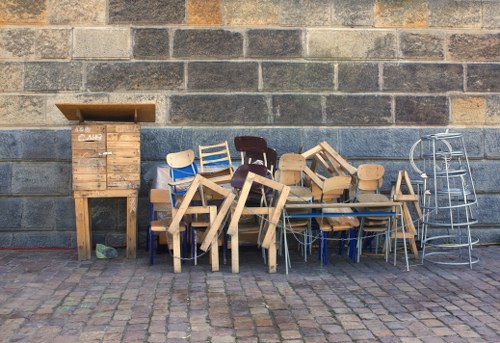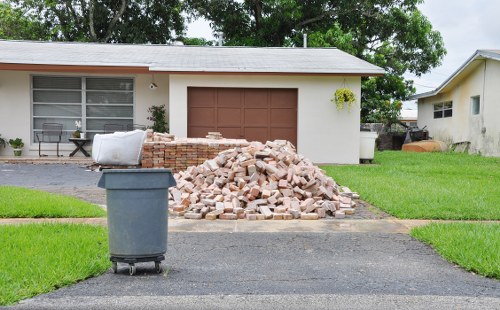Effective Furniture Disposal: A Comprehensive Guide
Understanding Furniture Disposal

Furniture disposal is a critical aspect of maintaining a clean and organized living or working space. Whether you're upgrading your furniture, moving to a new home, or simply decluttering, understanding the best practices for disposing of old furniture is essential. Proper disposal not only ensures environmental responsibility but also helps in reclaiming space efficiently.
There are various methods available for furniture disposal, each with its own set of advantages and considerations. From recycling and donating to selling and professional removal services, the options are diverse and can be tailored to meet individual needs.
Choosing the right disposal method depends on several factors, including the condition of the furniture, the type of items being discarded, and personal or organizational preferences regarding sustainability and cost-effectiveness.
Why Proper Furniture Disposal Matters

Proper furniture disposal is not just about making space; it's about contributing to environmental sustainability. Furniture items often contain materials that can be harmful if not disposed of correctly. By opting for responsible disposal methods, you help reduce landfill waste and promote the recycling of valuable materials.
Moreover, responsible disposal practices can also have financial benefits. Recycling or donating furniture can sometimes lead to tax deductions, while selling items can offset the cost of new purchases. It's a win-win situation that benefits both the environment and your wallet.
Additionally, improper disposal can lead to legal consequences, especially if the furniture contains hazardous materials. Staying informed and adhering to local disposal regulations is crucial to avoid potential fines and to ensure that your disposal methods align with community standards.
Methods of Furniture Disposal

- Recycling: Breaking down furniture into recyclable materials like wood, metal, and plastic.
- Donating: Giving usable furniture to charitable organizations or individuals in need.
- Selling: Listing furniture items for sale through online platforms or local marketplaces.
- Professional Removal: Hiring specialized services to handle large or complex disposal tasks.
- Repurposing: Creative transformation of old furniture into new, functional pieces.
Recycling Furniture

Recycling is an eco-friendly option that ensures furniture items are processed and reused, minimizing waste. This method involves separating materials such as wood, metal, glass, and upholstery, which can then be repurposed for new products.
To recycle furniture effectively, it's important to identify and sort the materials accurately. Many communities offer recycling programs specifically designed for large items, making the process more accessible and efficient.
Recycling not only conserves natural resources but also reduces the carbon footprint associated with manufacturing new furniture. By choosing this method, you contribute to a more sustainable future.
Donating Your Furniture

Donating furniture is a generous way to give new life to items that are still in good condition. Various charitable organizations accept furniture donations, using the items to support those in need or to fund community projects.
Before donating, ensure that the furniture is clean and in usable condition. Some organizations may offer pick-up services, making the donation process more convenient.
Donating not only helps others but can also provide you with potential tax benefits. It's a practical and compassionate solution for furniture disposal.
Selling Furniture Items
Selling your old furniture can be a profitable disposal method. Platforms such as eBay, Craigslist, and Facebook Marketplace provide ample opportunities to connect with potential buyers looking for quality used furniture.
When listing items for sale, provide clear descriptions and high-quality photos to attract more interest. Pricing items competitively based on their condition and market value can expedite the selling process.
Selling is not only a way to declutter but also an eco-friendly choice, as it extends the life cycle of the furniture and reduces the demand for new products.
Professional Furniture Removal Services
For those seeking hassle-free furniture disposal, professional removal services offer an efficient solution. These services handle everything from collection to disposal, saving you time and effort.
Professional removers are equipped to handle large or bulky items, ensuring that furniture is disposed of safely and in accordance with local regulations. They often provide additional services such as recycling, donation coordination, and even assembly and disassembly of items.
While there is a cost associated with professional services, the convenience and peace of mind they offer can be well worth the investment, especially for complex disposal needs.
Repurposing Furniture
Repurposing is a creative approach to furniture disposal that involves transforming old pieces into something new and functional. This method not only reduces waste but also allows for personalized and unique home decor.
Common repurposing ideas include turning old dressers into bathroom cabinets, converting wooden pallets into outdoor furniture, or updating old chairs with new upholstery.
Repurposing can be a rewarding DIY project that enhances your living space while promoting sustainable practices.
Legal and Environmental Considerations
When disposing of furniture, it's important to be aware of local laws and environmental regulations. Different regions may have specific guidelines regarding the disposal of large items, hazardous materials, and recycling requirements.
Ensuring compliance with these regulations not only avoids legal issues but also supports community efforts to manage waste responsibly.
Additionally, being mindful of environmental impacts by choosing sustainable disposal methods contributes to the overall health of the planet.
Cost-Effective Disposal Solutions
Disposing of furniture doesn't have to be expensive. There are several cost-effective options available, depending on your needs and the condition of your items.
- DIY Disposal: Renting a dumpster or using your vehicle to transport items to a recycling center.
- Community Services: Utilizing local government or nonprofit organization disposal programs.
- Trade-In Programs: Some retailers offer incentives for trading in old furniture when purchasing new items.
Evaluating these options can help you find the most affordable method for your specific situation.
Steps for Efficient Furniture Disposal
1. Assess Your Furniture
Begin by evaluating the condition of each piece. Determine whether it can be reused, donated, recycled, or needs to be disposed of as waste.
2. Choose the Right Method
Select the most appropriate disposal method based on your assessment. Consider factors such as cost, convenience, and environmental impact.
3. Prepare the Items
Clean and repair items if possible. This increases the chances of donation or sale and ensures safe handling during disposal.
4. Arrange for Transportation
Plan how you'll move the furniture to the chosen disposal site. This may involve renting a truck, scheduling a pickup, or arranging delivery to a recycling center.
5. Complete the Disposal
Finalize the disposal process by ensuring all items are properly processed according to the selected method. Confirm that donations are received, sales are completed, or recycling is handled appropriately.
Common Challenges in Furniture Disposal
Disposing of furniture can present several challenges, including logistical issues, costs, and finding the right resources. Navigating these obstacles requires planning and knowledge of available options.
- Space Constraints: Limited space for staging disposal can complicate the process.
- Cost Management: Balancing disposal costs with budget constraints.
- Regulatory Compliance: Staying informed about local disposal laws and regulations.
By anticipating these challenges, you can develop strategies to overcome them and ensure a smooth disposal experience.
Benefits of Sustainable Furniture Disposal
Adopting sustainable disposal methods offers numerous benefits, both environmentally and personally. It reduces landfill waste, conserves natural resources, and lowers carbon emissions associated with manufacturing new furniture.
- Environmental Preservation: Minimizing waste helps protect ecosystems and reduces pollution.
- Economic Advantages: Sustainable practices can lead to cost savings through recycling and donation incentives.
- Community Support: Donating furniture supports local charities and those in need.
Embracing sustainability in furniture disposal is a responsible choice that positively impacts the world around us.
Innovative Furniture Disposal Solutions
Advancements in technology and creative thinking have led to innovative solutions for furniture disposal. From app-based marketplaces to automated recycling centers, these innovations make the process more efficient and user-friendly.
- Online Marketplaces: Platforms like Freecycle and OfferUp facilitate easy selling and donating.
- Recycling Innovations: New technologies improve the efficiency of material separation and processing.
- Smart Scheduling: Apps that streamline scheduling pickups and deliveries with disposal services.
Staying informed about these innovations can enhance your furniture disposal strategy, making it more effective and sustainable.
Choosing the Right Furniture Disposal Service
Selecting a reliable furniture disposal service is crucial for a hassle-free experience. Consider factors such as service offerings, pricing, reputation, and environmental practices when making your choice.
Researching customer reviews, comparing quotes, and verifying certifications can help ensure that you partner with a trustworthy provider.
Investing in a reputable service guarantees that your furniture is disposed of responsibly and according to your preferences.
Preparing for Furniture Disposal
Proper preparation can streamline the disposal process. This includes disassembling large items, removing any hazardous materials, and organizing items based on their disposal methods.
- Disassemble Furniture: Break down large pieces to make transportation easier.
- Remove Hazardous Materials: Safely dispose of any components that may be harmful.
- Organize Items: Categorize furniture based on whether they will be recycled, donated, or sold.
These steps ensure a smooth and efficient disposal experience.
Maximizing the Value of Your Furniture
Before disposing of furniture, consider ways to maximize its value. Cleaning, repairing, and enhancing the appearance of items can increase their appeal for donation or sale.
Investing time in maintenance and minor repairs can significantly boost the item's market value, making the disposal process more beneficial.
Additionally, providing accurate descriptions and highlighting unique features can attract more potential buyers or recipients.
Environmental Impact of Furniture Disposal
The environmental impact of furniture disposal is significant, as it involves the management of large, often heavy items that require appropriate handling.
By choosing eco-friendly disposal methods, you contribute to reducing the overall environmental footprint. This includes selecting recycling over landfill disposal, supporting sustainable practices, and minimizing resource consumption.
Understanding the broader environmental implications helps in making informed decisions that benefit both you and the planet.
Future Trends in Furniture Disposal
The future of furniture disposal is moving towards greater sustainability and innovation. Trends include circular economy models, increased recycling capabilities, and the use of technology to facilitate easier disposal processes.
- Circular Economy: Emphasizing reuse and recycling to create a closed-loop system.
- Advanced Recycling: Developing more efficient methods for material recovery.
- Digital Platforms: Enhancing accessibility and convenience through online services.
Staying ahead of these trends can help you adopt more effective and responsible furniture disposal practices.
Conclusion
Furniture disposal is a multifaceted process that involves careful consideration of methods, environmental impact, and personal or organizational needs. By understanding the various options available and implementing best practices, you can dispose of furniture responsibly and efficiently.
Whether you choose to recycle, donate, sell, or utilize professional services, each method has its unique benefits and contributions to sustainability. Making informed decisions ensures that your furniture disposal aligns with both your goals and environmental responsibilities.
Contact us today to learn more about effective furniture disposal solutions tailored to your needs. Book your service now and take the first step towards a cleaner, greener, and more organized space.